Lasiodiplodia theobromae is the causal agent of a damaging root and collar rot disease on the biofuel plant Jatropha curcas in Brazil
O. L. Pereira A C , D. C. Dutra A and L. A. S. Dias BA Departamento de Fitopatologia, Universidade Federal de Viçosa, 36570-000 Viçosa, MG, Brazil.
B Departamento de Fitotecnia, Universidade Federal de Viçosa, 36570-000 Viçosa, MG, Brazil.
C Corresponding author. Email: oliparini@ufv.br
Australasian Plant Disease Notes 4(1) 120-123 https://doi.org/10.1071/DN09049
Submitted: 9 November 2009 Accepted: 16 November 2009 Published: 30 November 2009
Abstract
A damaging root and collar rot disease caused by Lasiodiplodia theobromae was observed on adult plants of Jatropha curcas in the states of Minas Gerais and São Paulo, Brazil. This is the first report of this disease in Brazil, previously only known from India.
Jatropha curcas L. (commonly known as physic nut in English and ‘pinhão manso’ in Portuguese), is a shrub belonging to the Euphorbiaceae family and is considered to be an important energy crop due to the production of vegetable oil, that can be utilised as a suitable alternative fuel resource (Dias et al. 2007). A great amount of pharmacological studies have also been undertaken with this species for multiple purposes. Recently, the planted area of this crop is increasing in Brazil due to government and industry incentives for suitable alternative fuel production for use in diesel engines. Jatropha curcas is considered to be resistant to drought. However, a new disease has been observed in Brazil, especially on plants undergoing drought stress. In 2008, adult plants of J. curcas grown in Jales (state of São Paulo), Nova Porteirinha and Barbacena (state of Minas Gerais) showed similar symptoms of yellowing (Fig. 1A), wilting (Fig. 1B), decaying of the collar region and rotted roots (Figs 2, 3), followed by the deaths of the plants, especially those undergoing drought stress. Black erumpent pycnidia were seen on the collar region (Fig. 4A) and black necrotic patches were observed when the bark was removed from the collar region (Fig. 4B). A blackening of the vascular region was consistently observed on collar and root regions of diseased plants (Fig. 5).
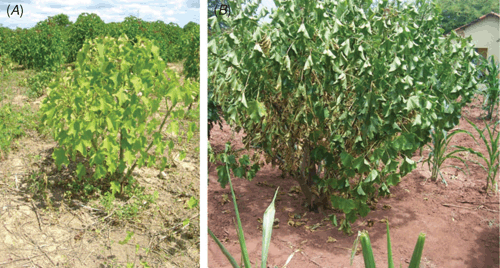
|
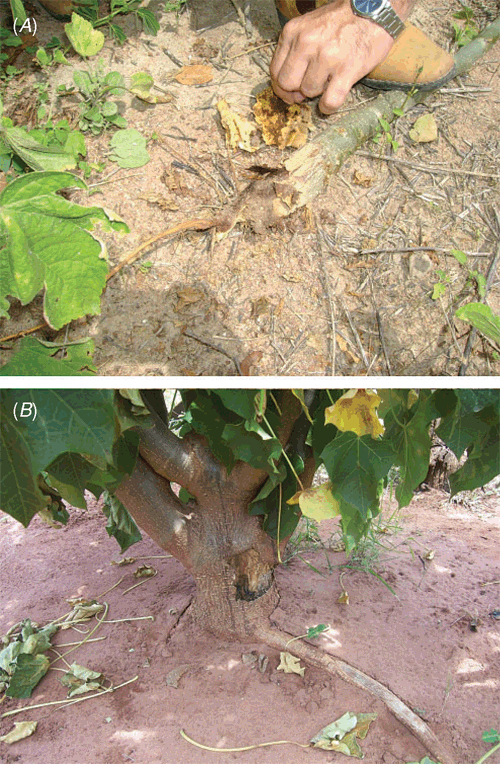
|
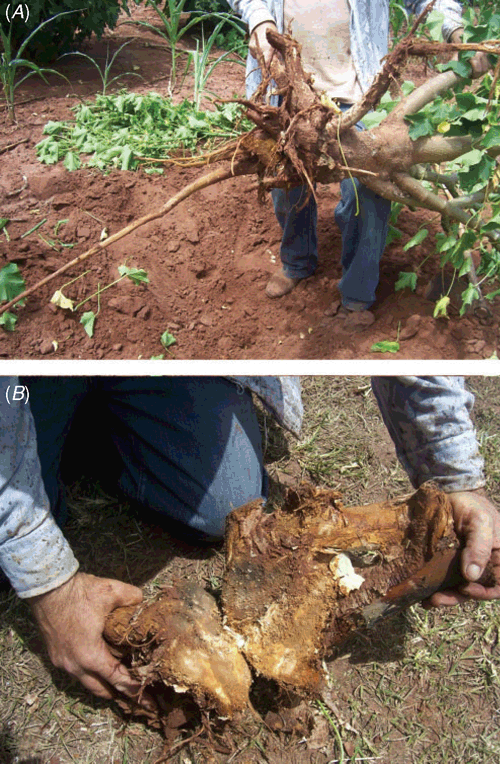
|
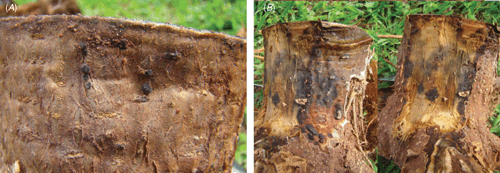
|
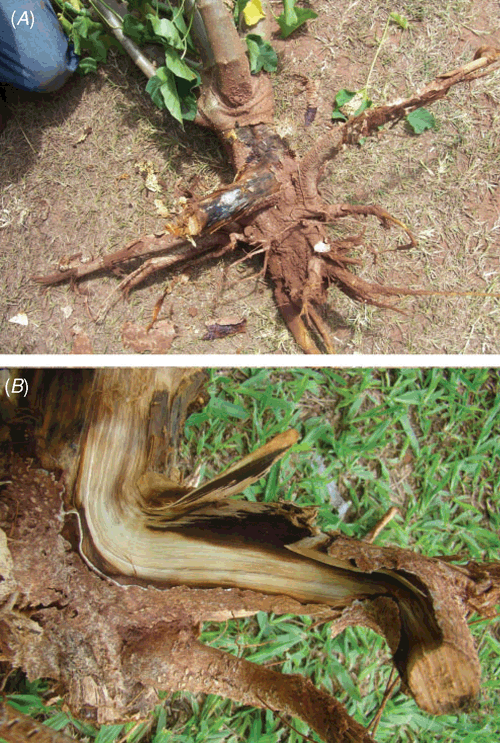
|
Associated with these symptoms was a fungus that had the following morphology: solitary pycnidia, pyriform, black, 150–175 × 190–210 μm, glabrous, with an apical ostiole, stromatic wall, composed of several layers of dark brown, thick-walled cells; conidia ellipsoidal, one-celled, hyaline when immature (Fig. 6A), becoming dark brown, striate and didymospore with age (Fig. 6B), 22.0–28.5 × 12.5–14.0 μm. The fungus fits the description of Lasiodiplodia theobromae (Pat.) Griffon & Maubl. (Punithalingam 1976). The fungus was isolated in culture (Fig. 6C).
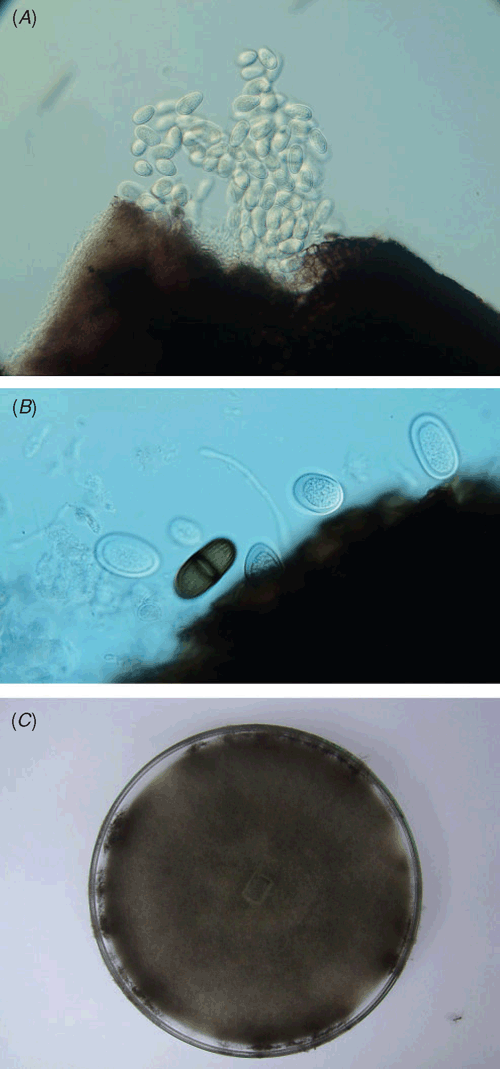
|
For inoculation, 5 mm diameter disks of bark (on the collar region of healthy plants) were taken with a sterile cork borer and replaced with 5 mm diamenter disks containing reproductive structures from the margins of a 7-day old colony growing on potato dextrose agar (PDA), covered with moist cotton and wrapped with Parafilm. Additional control plants were treated similarly but with PDA agar plugs instead of fungal inoculum. The inoculated plants were maintained in a greenhouse at 25°C. Browning of the collar region, similar to those described, were detected 1 month after the inoculation and the fungus was reisolated from the artificially inoculated plants. The control plants, on which only PDA plugs were placed on wounded stems, remained healthy. The fungus was reisolated in culture from the inoculated plants, thus satisfying Koch’s Postulates.
Lasiodiplodia theobromae has been reported to cause gummosis of Jatropha podagrica in China (Fu et al. 2007) and also to cause root rot and collar rot disease on Jatropha curcas in India (Latha et al. 2009). In Brazil, L. theobromae is a well-known pathogen commonly associated with root, collar and stem rot, dieback and post-harvest diseases on Anacardium occidentale (cashew nut), Annona spp., Carica papaya, cocoa, coconut palm, Hevea spp., Malpighia emarginata (Barbados cherry), mango, Ricinus communis and others (Kimati et al. 2005), but not previously reported causing root and collar rot disease on J. curcas. This pathogen can become a serious problem for this biofuel crop, since it can lead to the deaths of adult production plants and also due to the lack of registered chemical products for this pathogen on J. curcas in Brazil.
Acknowledgements
The authors wish to thank Ana Cristina P. Juhász (EPAMIG- Centro Tecnológico do Triângulo e Alto Paranaíba), Luciano Piovesan Leme (Fusermann Biocombustíveis), Fabiano Prudente de Moraes and José Antônio de Souza Júnior for sending diseased material from different regions. Special thanks to Ana C. P. Juhász for permission to use photographs utilised in Figs 1A and 2A and Fabiano Prudente de Moraes for the photographs utilised in Figs 1B, 2B, 3 and 5A. The authors also wish to thank Auxiliadora O. Martins who provided healthy J. curcas plants for inoculation.
Fu G,
Huang SL,
Wei JG,
Yuan GQ,
Ren JG,
Yan WH, Cen ZL
(2007) First record of Jatropha podagrica gummosis caused by Botryodiplodia theobromae in China. Australasian Plant Disease Notes 2, 75–76.
| Crossref | GoogleScholarGoogle Scholar |

Latha P,
Prakasam V,
Kamalakannan A,
Gopalakrishnan C,
Raguchander T,
Paramathma M, Samiyappan R
(2009) First report of Lasiodiplodia theobromae (Pat.) Griffon & Maubl. causing root and collar rot disease of physic nut (Jatropha curcas L.) in India. Australasian Plant Disease Notes 4, 19–21.



